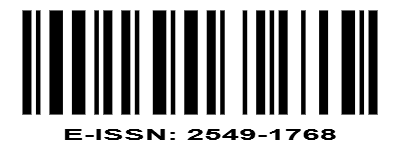ORGANOLEPTIC TESTS OF PEMPEK WITH VARIOUS SURIMI FORMULATIONS OF SANGKURIANG CATFISH (Clarias gariepsinus)
DOI:
https://doi.org/10.22373/biotik.v11i1.15688Keywords:
Pempek, Sangkuriang catfish, SurimiAbstract
This study aims to study various surimi formulations of Sangkuriang catfish (Clarias gariepsinus) for the resulting pempek, using the experimental method using a Randomized Block Design (RBD) arranged in a non-factorial manner with one treatment of various formulations of surimi Sangkuriang catfish (Clarias gariepsinus) consisting of of six factors and repeated four times. Pempek organoleptic test results with hedonic tests on color, aroma, and taste. The highest preference value for the color of pempek made from sangkuriang catfish surimi in the L1 treatment (0.25 parts of sangkuriang catfish surimi and 1.00 parts of tapioca flour) with a clean white pempek color typical of fish pempek with an average value of 4.30 (criterion panelists liked). The highest preference value for the taste and aroma of pempek made from sangkuriang catfish surimi was found in treatment L6 (1.50 parts of sangkuriang catfish surimi and 1.00 parts of tapioca flour) with a savory taste and dominant pempek aroma with an average value of 3 .90 (panelists preferred criteria) and 4.30 (panelists preferred criteria).Downloads
References
A. Gandhy, V. F. Nurunisa, and T. Situmeang, “Efficiency marketing chain analysis of sangkuriang catfish in minapolitan area,” Agriekonomika, vol. 8, no. 1, p. 14, 2019, doi: 10.21107/agriekonomika.v8i1.5016.
I. Zuraida, S. Raharjo, P. Hastuti, and R. Indrati, “Catfish (Clarias gariepinus): a potential alternative raw material for surimi production,” Pakistan J. Nutr., vol. 16, no. 12, pp. 928–934, 2017, doi: 10.3923/pjn.2017.928.934.
C. O. Mendivil, “Fish Consumption: a Review of its effects on metabolic and hormonal health,” Nutr. Metab. Insights, vol. 14, pp. 1–6, 2021, doi: 10.1177/11786388211022378.
D. Miyauchi, G. Kudo, and M. a X. Patashnik, “Surimi-a semi-processed wet fish protein,” Mar. Fish. Rev., vol. 35, no. 12, pp. 7–9, 1970, [Online]. Available: https://spo.nmfs.noaa.gov/sites/default/files/pdf-content/mfr35122.pdf.
U. T. Laksono, S. Suprihatin, T. Nurhayati, and M. Romli, “Enhancement of Textural Quality From Daggertooth Pike Conger Fish Surimi with Sodium Tripolyphosphate and Transglutaminase Activator,” J. Pengolah. Has. Perikan. Indones., vol. 22, no. 2, pp. 198–208, 2019, doi: 10.17844/jphpi.v22i2.27373.
S. B. Satam, S. T. Sharangdhar, M. T. Sharangdhar, I. K. Sajid, and U. D. Sonawane, “Surimi : the " high-tech " raw material from minced fish meat,” Fish. chimes, vol. 24, no. 8, pp. 49–55, 2004, [Online]. Available: https://www.researchgate.net/publication/317358900_Surimi_The_High-Tech_Raw_Material_from_Minced_Fish_Meat.
H. Kong, B. Zhou, X. Hu, X. Wang, and M. Wang, “Protective effect of perilla (perilla frutescens) leaf essential oil on the quality of a surimi-based food,” J. Food Process. Preserv., vol. 42, no. 3, pp. 1–8, 2018, doi: 10.1111/jfpp.13540.
Alhanannasir, Dasir, and Siti Patimah, “Nilai protein pempek dari jenis olahan daging ikan patin (pangasius pangasius) dan perbandingan tepung tapioka,” Edible, vol. 4, no. 1, pp. 1–12, 2004, [Online]. Available: file:///C:/Users/ACER/Downloads/3451-8491-1-SM (1).pdf.
A. Supriadi, D. Saputra, G. Priyanto, A. Baehaki, and R. Pambayun, “The profile of pempek as a determining factor of quality, originality and ethnicity,” J. Phys. Conf. Ser., vol. 1485, no. 1, pp. 1–7, 2020, doi: 10.1088/1742-6596/1485/1/012032.
Alhanannasir and Idealastuti, “Maintaining the chemical value and organoleptic properties of pempek with the frequency of ice water washing method,” IOP Conf. Ser. Earth Environ. Sci., vol. 515, no. 1, pp. 1–9, 2020, doi: 10.1088/1755-1315/515/1/012058.
U. Pato, Y. Yusuf, R. F. Isnaini, and D. M. Dira, “The quality of instant noodle made from local corn flour and tapioca flour,” J. Adv. Agric. Technol., vol. 3, no. 2, pp. 118–123, 2016, doi: 10.18178/joaat.3.2.118-123.
K. Wuttisela, S. Shobsngob, W. Triampo, and D. Triampo, “Amylose/amylopectin simple determination in acid hydrolyzed tapioca starch,” J. Chil. Chem. Soc., vol. 53, no. 3, pp. 1565–1567, 2008, doi: 10.4067/S0717-97072008000300002.
L. Sheng et al., “Tapioca starch-pullulan interaction during gelation and retrogradation,” Lwt, vol. 96, no. May, pp. 432–438, 2018, doi: 10.1016/j.lwt.2018.05.064.
P. Suppakul, “Moisture sorption isotherm and texture of glassy tapioca-flour-based baked products,” in The 12th ASEAN FOOD CONFERENCE, 2016, no. August, pp. 254–259.
S. Khalili Tilami and S. Sampels, “Nutritional value of fish: lipids, proteins, vitamins, and minerals,” Rev. Fish. Sci. Aquac., vol. 26, no. 2, pp. 243–253, 2018, doi: 10.1080/23308249.2017.1399104.
P. C. de Souza and G. O. Bonilla-Rodriguez, “Fish hemoglobins,” Brazilian J. Med. Biol. Res., vol. 40, no. 6, pp. 769–778, 2007, doi: 10.1590/s0100-879x2007000600004.
G. S. Rombe, M. M. Tahir, and A. B. Tawali, “Physicochemical characteristics of pempek premix flour made from mackerel fish (Scomberomorus commersoni) surimi powder,” IOP Conf. Ser. Earth Environ. Sci., vol. 564, no. 1, pp. 1–8, 2020, doi: 10.1088/1755-1315/564/1/012042.
D. D. Jayasena, D. U. Ahn, K. C. Nam, and C. Jo, “Flavour chemistry of chicken meat: a review,” Asian-Australasian J. Anim. Sci., vol. 26, no. 5, pp. 732–742, 2013, doi: 10.5713/ajas.2012.12619.
Dr. Richard van der Laan, FRESHWATER, 22nd ed. Netherland: ALMERE, 2017.
D. T. Utama, S. G. Lee, K. H. Baek, A. Jang, J. I. Pak, and S. K. Lee, “Effects of high-pressure processing on taste-related atp breakdown compounds and aroma volatiles in grass-fed beef during vacuum aging,” Asian-Australasian J. Anim. Sci., vol. 31, no. 8, pp. 1336–1344, 2018, doi: 10.5713/ajas.17.0677.
M. G. Sarower, A. Farah, M. Hasanuzzaman, B. Biswas, and H. Abe, “Taste producing components in fish and fisheries products : a review,” J . Food . Ferment . Technol, vol. 2, no. 2, pp. 113–121, 2012.
Downloads
Published
Issue
Section
License
Authors who publish with BIOTIK: Jurnal Ilmiah Biologi Teknologi dan Kependidikan agree to the following terms:
- Authors retain copyright and grant the journal right of first publication with the work simultaneously licensed under a Creative Commons Attribution License that allows others to share the work with an acknowledgement of the work's authorship and initial publication in this journal.
- Authors are able to enter into separate, additional contractual arrangements for the non-exclusive distribution of the journal's published version of the work (e.g., post it to an institutional repository or publish it in a book), with an acknowledgement of its initial publication in this journal.
- Authors are permitted and encouraged to post their work online (e.g., in institutional repositories or on their website) prior to and during the submission process, as it can lead to productive exchanges, as well as earlier and greater citation of published work.











